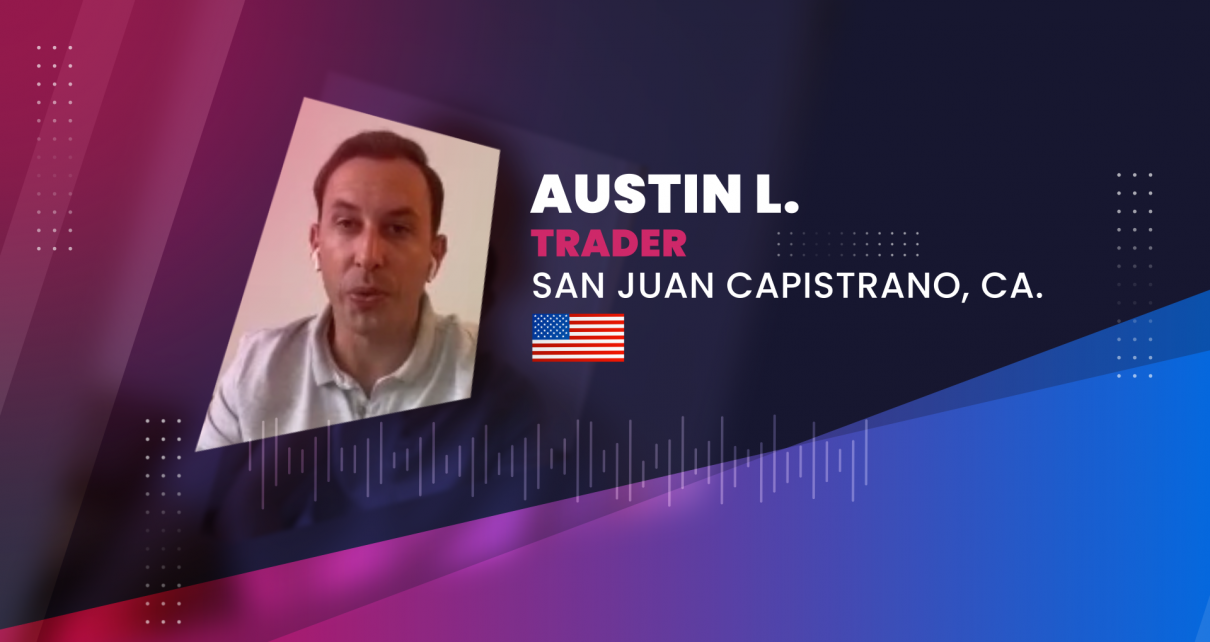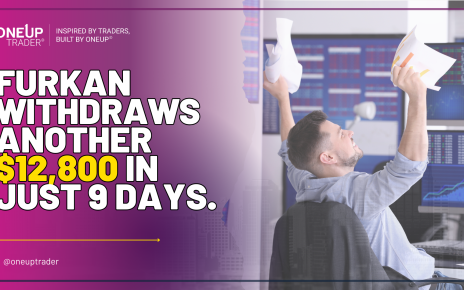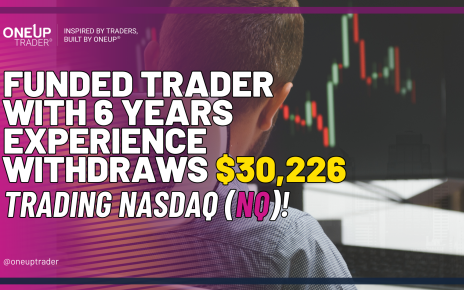In this interview, Austin discusses his trading journey, his experience with Topstep, how he found OneUp Trader, why he chose OneUp Trader instead of other funding companies, his trading style and trading process of the day, and more. He equally shares how OneUp Trader helped him to become a better trader and offers his advice to traders. You can listen to him by following this link.
How he found OneUp Trader
Concerning how he found OneUp Trader, he says, he was using Topstep Trader and he just didn’t really like it there because there are so many rules with TopStep and it was kind of frustrating.
Moreover, during the coronavirus lockdown, TopStep changed the rule that you can’t be within 2% of a circuit breaker and trading that contract, which he thinks was kind of a difficult time because the S and P he was trading was doing that consistently overnight. Therefore, he decided to peel away from Topstep.
He also noted that that was how he kind of found OneUp Trader – he was just looking online and searching around and finally, he found OneUp Trader.
Why choose OneUp Trader and why not other funding companies?
To this question, Austin says, he thinks he started trading with OneUp consistently probably since, July or August last year. However, he was with Topstep for like a year and a half and had some withdrawals with them.
But then again, he says, it was just kind of hard to get moving forward with Topstep because their strict rules mean he was only allowed such a tight window of risks. And then he kind of wants to move somewhere that will let him trade with his stops and allow him to move forward without so many precise rules detailing when he can be in and out of the market. So, he’s just moving forward.
He has been managing his own money for a while. He had an account with the Interact Brokers for quite a while, like a few years.
He also got frustrated with them because they would call him asking him a lot of questions. Also, to pass the evaluation process they made him get profit twice. Another big thing for him is that they made him pay data fees and he felt like, maybe the company is only letting him risk a few thousand dollars for the account. The data fee the company charged him was $500 a month.
Regarding why he decided to stick with OneUp, he says with OneUp, he doesn’t have to pay the data fees, which is huge. Also, he says, as long as you have a process and rules-based system, it’s really, hands-off and if you need support, OneUp’s support team is there, but essentially, you know, it’s all up to you. He further says, while there are a few rules of where you can be holding trades through reports, which he says, he understands, but other than that, working with OneUp according to him is pretty straightforward.
How he started and how long he has been trading
Concerning when he started trading, he says he actually started his career as a trader when he finished college. He got into being with futures broke eight years ago and so basically, he has been trading futures ever since. He did that for about four or five years and then he worked for a prop firm in New York that dealt with futures trading. He says, he has been trading futures for a while, and then he worked with another company, an online trading academy where he was just educating people and showing them how to do futures trading and what have you.
So, he says, he has been close to the futures market and has been trading futures daily for eight years. With OneUp evaluation, he says, he first started with a $50K account and he was actually profitable on it. However, he decided to close the account and trade with the $150K account option because he just needed more wiggle room. He risks about $500 in a trade. He thinks he did that like late July, early August, perhaps.
His trading Style
Regarding his trading style, he says, because of the way he finds a certain zone, his trading style is definitely discretionary. But once that zone is located, he’s pretty robotic. He sets up his trades and he doesn’t even watch it. He lets it be. Either it gets hit or it doesn’t get hit. He normally has his targets set up and sometimes, his targets aren’t hit by the end of the day.
If that happens, he just closes out the trade, but more or less he is looking for a big move out of a consolidation area. And he says, “Once that big move happens, you know, once they pull us back to that area, then I’ll look to get, a longer short, depending on where it is on the chart.”
His whole idea of trade is that the institutions can’t get all their orders off on one go and that when the markets come back to those high volumes breakaway areas, there are more orders there and the market is going to make a turn and a turnaround.
His advice to traders
Regarding his advice to traders, he says, “get off the small timeframes. If you’re reading how to trade online, you know, it doesn’t work. You got to look at bigger timeframes and anticipate bigger moves”. In conclusion, he says, “it’s hard to be consistently successful looking at a 5, 10, 15-minute chart, right”?
Further, he says, Goldman Sachs and JP Morgan aren’t looking at five-minute zones or some candlestick formation on the five-minute chart. Now, they’re looking at daily or weekly moves. So, he says, one should be able to kind of have a lower risk area on. In conclusion, some sort of formation on a bigger timeframe is really going to expedite your success.
Trading process of the day
To this question, he says, he trades from Newport Beach, California. So, for him, his trading process is a little earlier from 5.30 am in the morning till about 7.30 am. He’s looking over all the markets and on various timeframes. And then depending on the trading day, he set his trades up, set his targets up and they either get hit or they don’t, and that’s pretty much all about his trading day. He used to be a little bit more active, always trading the S and P 5 to 10 times a day.
He had some really great winners. Then he had some pretty, more or less win and some loss, but it wasn’t very consistent.
So, he’s just looking at all products and looking for those moves. He believes that there’s going to be such an opportunity, but this week there really weren’t many trades for him. He traded a few times, like twice in New Zealand short, but he basically made a little profit. Then he lost an S and P trade overnight, but more or less, he was looking at the markets within those first two hours. He would look at that and look at them again. And when the market opens at three o’clock in the afternoon, he looks again just to set up some things for overnight trading. After he has done that, he kind of repeat the process, and the Sunday market opened a big move for him.
He would play gaps in currencies or the S and P or what have you. So, when he knows all the markets that he’s looking at for Sunday, Monday or Tuesday, he just sets them up automatically. He normally gets an alert before it gets to the zone he wants to trade, just to make sure that it arrives well. If it arrives through a slow crawl down there, it signals to him that it’s probably not so good. However, if it arrives there pretty quickly, he knows that it is a trade he is looking forward to.
His experience on the connection process
Concerning this question, he says, it was really smooth, simple and straightforward on what when it comes to how to pass the evaluation and what you need to look for. Furthermore, he says the funding process was quick. He thinks it took him a few days to get the account set up and running. He says, once the account is set up, you’re kind of on your own from there. So, as long as you’re consistent, strategic and you’re not too emotional, it’s really a seamless process and he has been pretty happy with it so far.
His experience with OneUp support team
Concerning his experience with the OneUp team, he says, he just had to contact the team on the night before the election, when the election was kind of gearing up. His software wasn’t working where he would be able to execute the trade. He sent a quick email to the team and within 20 minutes, OneUp fixed it and he was good to go. In conclusion, he says, it’s pretty straightforward. Here is the link to the video interview.
How OneUp Trader helped him to grow as a trader
Concerning this, he says the one thing that he realized is, sometimes his trades aren’t getting hit during the week or a week like this, where it’s just really ranging. It made him lose his patience, to say the least. So, he started forcing some trades overnight. He’ll try searching for a few directional breakouts. But with the OneUp system, he can’t really go that way. It tells him, no, it isn’t really worth it. No, you can’t really risk too much capital. You might as well just be patient, wait for one of your great setups rather than just try to force a breakout because you’re impatient and didn’t make any money in the last day or two.
The OneUp features he likes
Concerning the OneUp’s features he likes, he said he likes the easy access to capital. For him, that would be the main thing. It’s pretty straightforward and a quick funding process where some of these brokerages could take weeks to fund you. Yeah, he says, even within the US, if he opens up brokerage accounts, they’ll take 10 to 12 days, if not longer, which can be frustrating if the markets are not only moving a lot and, you know, it could be five, seven days a month. In conclusion, he says, the ease of getting funding with OneUp is crucial.
Important thing learned through evaluation
Regarding what he learned through the evaluation, he says, “patience”. Waiting for the good traits before jumping in is really kind of the big thing. Further, he says, everyone’s kinda always discussing the opportunities that are out there, but being able to evaluate the risk-reward and the probability of the trade is so crucial because the nice thing with OneUp, is as long as you’re profitable, you’re going to be doing great. So, he says, it’s just better to be patient rather than just kind of force breakouts and trade with your emotions.
Will he recommend OneUp to others and why it is the best?
Concerning this, he says, he definitely has colleagues that are traders. He would recommend OneUp Trader to them just because, it’s wonderful not to have to trade your own capital and still get profitable. He further says, the breakdowns of withdrawals at OneUp are phenomenal, and keeping your first eight grand and then 80% split from there going forward, just reduces the headache of having your own capital. For him, it gives you more freedom to make investments elsewhere, or what have you, or cover your living costs for a few months while you get your account up and running.
How the transition into the Funded Account went for him
“It was simple”, he says. He thinks he gave a call to the OneUp Trader and said that he completed his evaluation correctly in probably his first 15 days. And then from there, the team said, great. He filled out a quick questionnaire and got the information from the funding partner. And within, perhaps, 24 hours, the OneUp team reached out to him to fill out the questionnaire, in maybe 48 hours. He was set up and running within five trading days. So, for him, it was really very simple. He just filled a couple of online forms.
What does he think about OneUp’s rules?
Concerning OneUp’s rules both during the evaluation and transitioning to a funded account, Austin says, ” for the most part, there’s the scaling dynamic rule, I think or there’s one rule that might change as far as how many lots you can trade at a time.”
However, he says, it’s no big deal though, because he’s not really risking more than 500 bucks in a trade.
So, he says, it’s not like he needs to trade 10 lots. In conclusion, he says, other than that, it’s exactly what he expects. Also, concerning the evaluation and funded account rules, he says, there are a couple of little changes, but realistically it’s pretty much the same thing.
About the Funding Partners
Regarding the funding partners, he says, they’ve been phenomenal. He hasn’t talked to them, but they sent him an email. They gave him their contact information if he had any questions and, that was that.
His trading setups
About his trading setups, he says, he has a 48 inch TV that he uses to look at his charts, but that’s about it. And then, he connects the TV to either the computer or laptop depending on where he is. However, he says, it’s pretty straightforward. Again, he doesn’t look at the charts all day long. He just sets things up in the morning. If they get hit, great, and if they don’t that’s okay too. For him, if that happens, he believes there’s always the next day.
How he trades
Regarding how he trades, Austin says, he follows his rules. He would trade religiously, not blindly. So, occasionally, he will kind of trade-off a news announcement or some huge news.
And if he is tempted to jump in, he controls himself because he has a strict risk profile. He never risks more than X amount of dollars per trade. So, if the zone is bigger than he thought, then he’ll do minis or do fewer contracts. But for the most part, he’s pretty calculated because he believes that there will always be an opportunity if he misses it in the S and P more or less. There’ll be that same opportunity to trade it in the tenure of the bond. So, as long as the moves are out there, he can get himself set up for maybe gold rather than other things. But he would definitely say he follows his rules 97% of the time.
His proper trading plans and goals
For his proper trading plans, he says, what he aims for with his $150,000 accounts is trying to kick off with 5 lots, 10, 15 grand a month in the beginning, and he then just kind of keeps adding more lots to it.
The nice thing and the wonderful thing about trading for him are that it’s really scalable. So, he has a pretty good rule system. And once it works, instead of trading two contracts or it’s getting to the 500 portrayed, he’ll start risking a grand or $1,500 and just keep moving up. And that’s the nice thing about when he is trading.
He also added that once you show consistency and profitability, you can really scale your trading because then you just start trading 10 lots instead of 2 lots and move forward from there. But, in the beginning, he says, he’s just kind of aiming for $5,000 to $15,000 a month to keep moving forward and then, scale up from there.
About analytics and dashboard
Regarding analytics and dashboard, Austin says, it’s really helpful for the evaluation. It helps the trader to get a good idea. However, for the most part, he has a spreadsheet that he uses on his side that he uses to keep track of everything. He says, ” the spreadsheet helps me with notes and more of the mental side of things. But yeah, the analytics is great. The dashboard looks good and helpful to know exactly where you stand”. You can follow this link to listen to him speak in the video interview.
His advice to traders about the evaluation
Regarding his advice to traders about the evaluation, he says, “trade with a stop”. The second advice would be, ” limit yourself to several trades you can do per day”. Doing so, he says, ” would help you to develop per day and will help you wait for the better ones. Furthermore, he says, “you know, one good trade is equivalent to two average ones or what have you”. In conclusion, Austin explains that it’s just not worth it, you know, we’re just waiting for the good one. To listen to him speak, you can follow this link.





